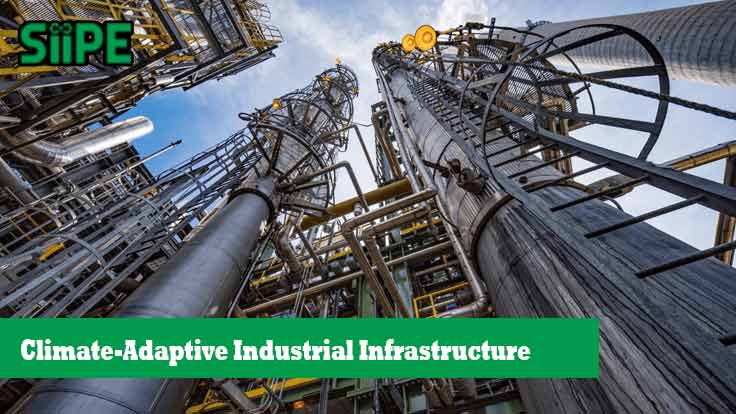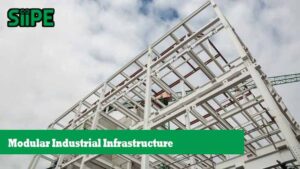Climate change is no longer a distant threat—it’s a present reality that affects every sector, including industry. Rising temperatures, unpredictable weather patterns, sea-level rise, and extreme events like floods and droughts are already disrupting supply chains and damaging facilities.
To stay resilient and sustainable, industries must shift towards climate-adaptive infrastructure—a new era of planning and development that incorporates environmental risks into the core of industrial design.
🏭 What Is Climate-Adaptive Industrial Infrastructure?
Climate-adaptive industrial infrastructure refers to buildings, systems, and operational frameworks designed specifically to withstand, respond to, and recover from climate-related stress. It’s not just about being “green”—it’s about being resilient and future-proof.
Key characteristics include:
-
Resilience to climate extremes (heat, storms, flooding)
-
Low-carbon footprint
-
Flexibility for future adaptation
-
Sustainable energy and resource usage
🔥 Why Is It Urgent?
According to the Intergovernmental Panel on Climate Change (IPCC), global warming is expected to cross the 1.5°C threshold by the early 2030s. This has severe implications for industrial zones, especially those near coasts, rivers, or deserts.
Without climate-adaptive design, industries face:
-
Damage to infrastructure from extreme weather
-
Disrupted operations and lost productivity
-
Supply chain failures
-
Higher maintenance and insurance costs
-
Regulatory non-compliance
🧱 Elements of Climate-Adaptive Infrastructure
1. Elevated and Flood-Resistant Construction
Factories and warehouses are being built with raised foundations, permeable pavements, and flood-barrier systems to reduce vulnerability to water damage.
2. Green Energy Integration
Incorporating solar, wind, and geothermal energy sources reduces dependency on fossil fuels and enhances energy security during grid disruptions.
3. Smart Water Management
Climate-adaptive infrastructure includes rainwater harvesting, wastewater recycling, and drought-resistant landscaping to mitigate water scarcity and reduce flood risks.
4. Heat-Resilient Materials and Ventilation
With global temperatures rising, industries are using cool roofing materials, green walls, and passive cooling systems to maintain indoor temperatures and reduce energy consumption.
5. Circular Waste Systems
Designing infrastructure with zero-waste targets and material recovery systems reduces environmental impact and enhances sustainability.
6. Early Warning and Monitoring Technology
IoT sensors and AI systems are used to monitor environmental conditions (e.g., temperature, humidity, soil movement) and alert operators to risks in real-time.
📈 Benefits of Climate-Adaptive Industrial Infrastructure
-
Operational Continuity – Reduced disruptions from weather events
-
Cost Savings – Lower maintenance and energy bills in the long term
-
Regulatory Compliance – Meet environmental and climate-related regulations
-
Positive Brand Image – Boost investor and customer confidence
-
Workforce Safety and Comfort – Better working conditions in extreme climates
🌐 Case Studies of Climate-Adaptation in Industry
📍 Rotterdam, Netherlands
The port city is upgrading its industrial zone with floating structures, water plazas, and climate dikes. These allow industrial activities to continue even during heavy flooding.
📍 Singapore’s Jurong Island
As part of its climate resilience strategy, Singapore is investing in elevated platforms, sea walls, and resilient energy grids for its major industrial cluster.
📍 Toyota Motor Corporation
Toyota’s factories in Japan and Southeast Asia use solar-powered backup systems, emergency drainage, and wind-resistant architecture to prepare for typhoons and heatwaves.
🧩 How to Implement Climate-Adaptive Infrastructure
1. Climate Risk Assessment
Use geographic and climate data to identify vulnerable areas—flood zones, drought-prone locations, storm paths, etc.
2. Integrated Design
Architects, engineers, climate scientists, and industrial planners must collaborate to build infrastructure that adapts to local climate realities.
3. Invest in Modular and Flexible Systems
Create structures that can be easily modified or upgraded as climate patterns evolve.
4. Use Public-Private Partnerships
Collaboration between governments, industries, and research institutions can unlock funding, innovation, and expertise.
5. Adopt Digital Twins
Simulate how infrastructure will perform under various climate scenarios using digital twin technology—allowing proactive design changes before building even begins.
📉 Challenges to Overcome
-
High Initial Costs – Long-term savings often require upfront investments.
-
Lack of Climate Data – In some regions, localized and accurate climate forecasting is still limited.
-
Policy Gaps – Not all countries or regions have mandatory climate-resilient building codes.
-
Resistance to Change – Traditional industries may be slow to adopt new planning paradigms.
🔄 A Call for Climate-Resilient Industrial Parks
Rather than designing single buildings in isolation, governments and developers are now investing in entire climate-resilient industrial parks, where all infrastructure is built with adaptive capacity. This includes:
-
Shared stormwater systems
-
Centralized green energy plants
-
Integrated waste processing
-
Real-time climate monitoring hubs
🧠 Final Thoughts
The future of industry lies in adaptability. As climate change accelerates, businesses that fail to plan for environmental risks risk becoming obsolete. Climate-adaptive industrial infrastructure is more than a sustainability buzzword—it’s a smart, strategic investment.
Whether you’re planning a factory, warehouse, or an entire industrial zone, the message is clear: build for the climate of tomorrow, not just the needs of today.











